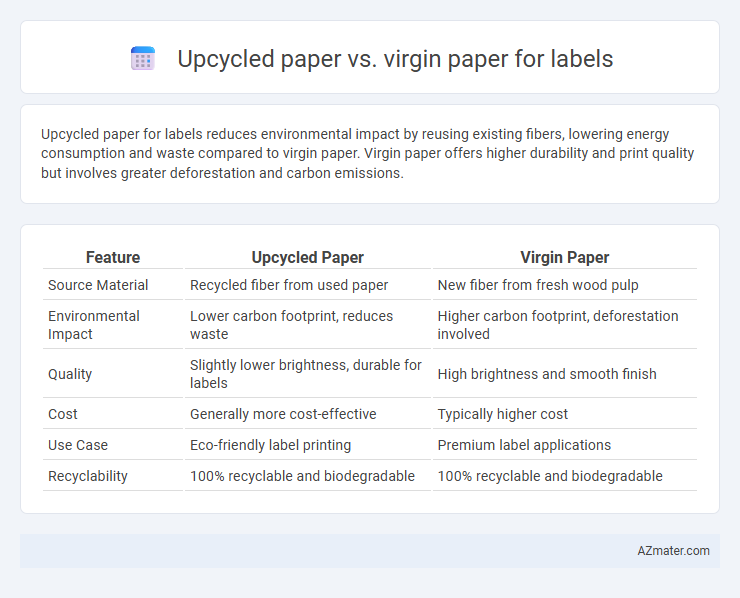Upcycled paper for labels reduces environmental impact by reusing existing fibers, lowering energy consumption and waste compared to virgin paper. Virgin paper offers higher durability and print quality but involves greater deforestation and carbon emissions.
Table of Comparison
| Feature | Upcycled Paper | Virgin Paper |
|---|---|---|
| Source Material | Recycled fiber from used paper | New fiber from fresh wood pulp |
| Environmental Impact | Lower carbon footprint, reduces waste | Higher carbon footprint, deforestation involved |
| Quality | Slightly lower brightness, durable for labels | High brightness and smooth finish |
| Cost | Generally more cost-effective | Typically higher cost |
| Use Case | Eco-friendly label printing | Premium label applications |
| Recyclability | 100% recyclable and biodegradable | 100% recyclable and biodegradable |
Introduction to Upcycled and Virgin Paper Labels
Upcycled paper labels are crafted from reclaimed paper materials, reducing waste and lowering environmental impact by reusing fibers from previously processed paper. Virgin paper labels are produced from freshly harvested wood pulp, offering higher strength, brightness, and purity but with a greater ecological footprint due to resource extraction and energy consumption. Choosing between upcycled and virgin paper labels depends on sustainability goals, print quality requirements, and the specific application of the label.
Environmental Impact Comparison
Upcycled paper labels significantly reduce environmental impact by using recycled fibers, which lowers energy consumption and decreases deforestation associated with virgin paper production. Virgin paper labels require harvesting fresh wood pulp, leading to higher greenhouse gas emissions and increased water usage throughout manufacturing. Choosing upcycled paper for labels minimizes landfill waste and conserves natural resources, making it a more sustainable option for eco-conscious packaging solutions.
Resource Consumption and Sustainability
Upcycled paper for labels significantly reduces resource consumption by reusing existing fibers, minimizing the need for fresh raw materials and lowering water and energy usage compared to virgin paper production. Virgin paper requires extensive deforestation, higher water consumption, and increased carbon emissions, contributing to environmental degradation. Choosing upcycled paper supports sustainability by promoting waste reduction and conserving natural resources, making it a more eco-friendly option for label manufacturing.
Production Processes: Upcycled vs. Virgin Paper
Upcycled paper for labels is made by repurposing existing paper materials, reducing waste and energy consumption through less intensive pulping and bleaching processes compared to virgin paper. Virgin paper production involves extracting raw wood fibers, requiring more water, chemicals, and energy, which leads to higher environmental impacts. The simplified production of upcycled paper supports sustainability goals by minimizing deforestation and lowering carbon emissions associated with label manufacturing.
Quality and Performance Differences
Upcycled paper for labels often features a slightly rougher texture and lower brightness compared to virgin paper, which can affect print clarity and color vibrancy. Virgin paper, made from fresh fibers, provides superior strength, smoothness, and water resistance, ensuring higher durability and consistent performance in labeling applications. Performance differences also include better ink adhesion and sharper image reproduction on virgin paper, while upcycled options offer environmental benefits but may require specialized inks and coatings to achieve similar quality.
Cost Analysis and Economic Benefits
Upcycled paper for labels offers significant cost savings compared to virgin paper due to lower raw material expenses and reduced energy consumption during production. Using upcycled paper supports circular economy principles by minimizing waste and decreasing landfill costs, which enhances long-term economic benefits for manufacturers. Although virgin paper may provide higher initial quality, the cost-effectiveness and environmental advantages of upcycled paper increasingly drive its adoption in label production.
Branding and Eco-conscious Market Appeal
Upcycled paper for labels enhances brand identity by showcasing a commitment to sustainability, attracting eco-conscious consumers who prioritize environmentally responsible products. Virgin paper, while offering consistent quality and printability, lacks the sustainable narrative that resonates with green markets. Brands leveraging upcycled paper gain a competitive edge by aligning their packaging with growing consumer demand for eco-friendly solutions, improving brand loyalty and market appeal.
Regulatory Standards and Certifications
Upcycled paper for labels often requires adherence to sustainability certifications such as FSC Recycled or PEFC Recycled, ensuring compliance with environmental regulations and reducing carbon footprint. Virgin paper labels must meet strict regulatory standards like FDA or EU guidelines for food safety and chemical migration, guaranteeing product safety and quality. Both materials can achieve certifications like ISO 14001 for environmental management, but upcycled paper excels in promoting circular economy compliance and eco-labeling requirements.
Challenges and Limitations of Each Paper Type
Upcycled paper for labels presents challenges such as inconsistent fiber quality and limited availability, which can affect print clarity and durability. Virgin paper offers superior strength and uniformity but involves higher environmental costs due to deforestation and energy-intensive production processes. Both paper types face limitations in water resistance and adhesive compatibility, necessitating careful selection based on specific label requirements.
Choosing the Right Paper for Labels
Selecting the right paper for labels involves evaluating the benefits of upcycled paper versus virgin paper, where upcycled options reduce environmental impact by reusing materials and conserving resources. Virgin paper offers superior smoothness and strength, ensuring high-quality print results and durability for labels exposed to various conditions. Prioritize factors such as label application, print quality, environmental sustainability, and cost when deciding between upcycled and virgin paper to meet branding and functional needs.

Infographic: Upcycled paper vs Virgin paper for Label
 azmater.com
azmater.com